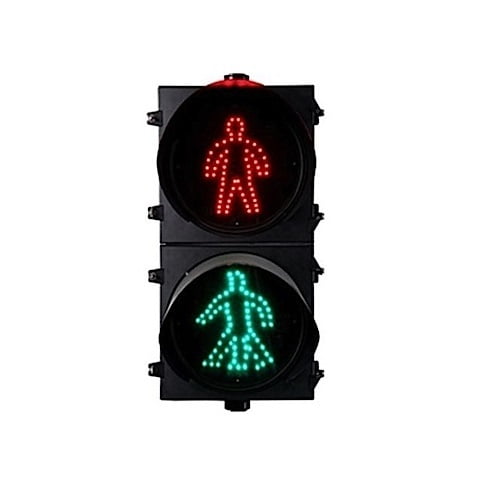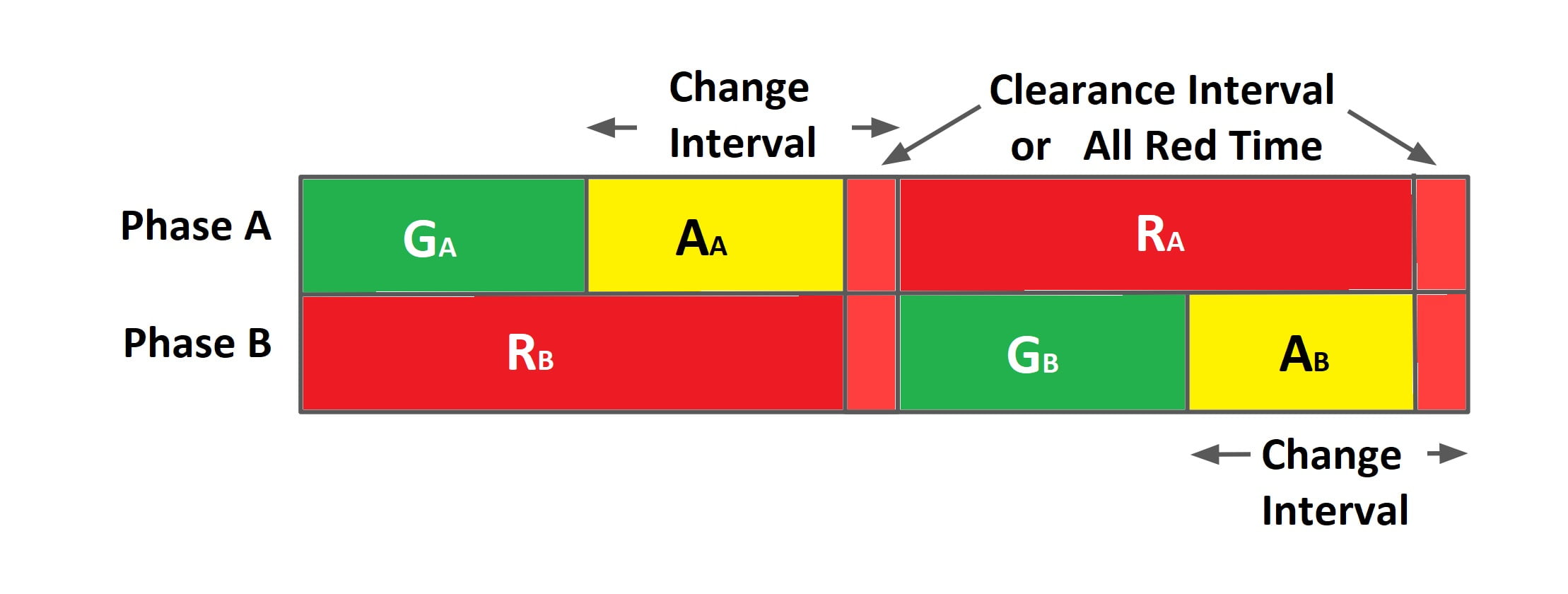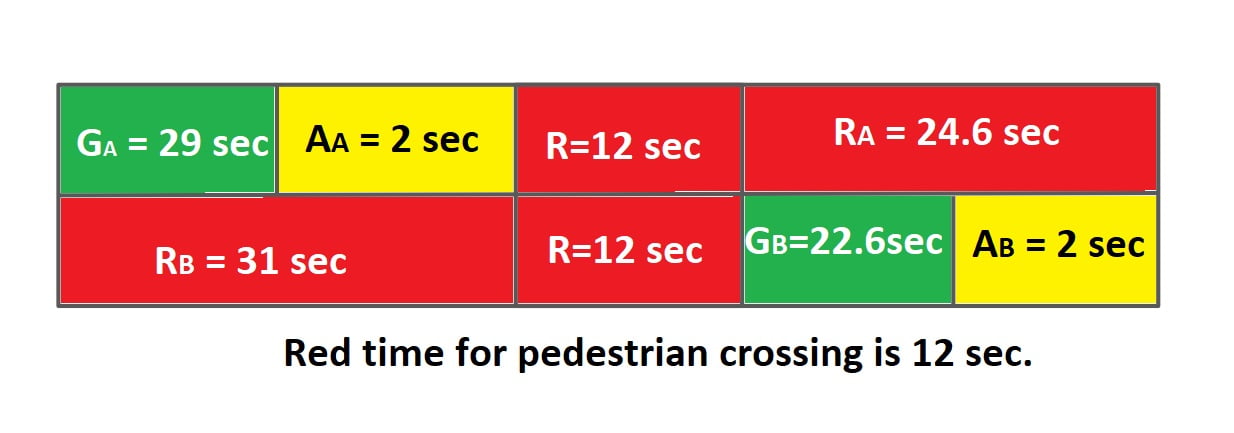Traffic Signals
Traffic signals are control devices which could alternately direct the traffic to stop and proceed at intersections using red and green traffic light signals.
The main requirement of traffic signals are
- It should draw the attention of road user.
- It should provide meaning & time to respond.
- It should have minimum waste of time.
Type of Traffic Signals
The signals are classified into the following types:
- Traffic Control Signals
- Fixed-time Signal
- Manually Operated Signal
- Traffic Actuated (automatic) Signal
- Pedestrian Signal
- Special traffic Signal
Traffic Control Signals
Traffic Control Signals have three colored light glows facing each direction of traffic flow. The Red light is meant for “Stop“, Green light indicates “GO” and the Amber light allows the clearance time for the vehicles which enter the intersection area by the end of green time.

Traffic control signals are of three types:
Fixed-time Signal
In Fixed Time Signal the timing of each phase of the cycle is predetermined base on the traffic studies. The main drawback of this is that some times the traffic flow on one road may be almost nil and traffic on cross road may be quite heavy but signal operates with fixed timings.
Traffic Actuated (automatic) Signal
Traffic actuated signals are those in which the timings of phase and cycle are changed according to traffic demand.
- Semi-actuated Signal is a signal whose timing (cycle length, green time, etc.) is affected when vehicles are detected (by video, pavement embedded inductance loop detectors, etc.) on some, but not all, approaches. This mode of operation is usually found where a low-volume road intersects a high-volume road. In such cases, green time is allocated to the major street until vehicles are detected on the minor street: the the green indication is briefly allocated to the minor street and then returned to the major street.
- Fully Actuated Signal is a signal whose timing (cycle length, green time, etc.) is completely influenced by the traffic volumes, when detected, on all of the approaches. Fully actuated signals are most commonly used at intersections of two major streets.
Manually Operated Signal
These signals are operated manually and not commonly used. In these types of signals, the traffic police watches the traffic demand from a suitable point during the peak hours at the intersection and varies the timings of these phases and cycle accordingly.
Pedestrian Signal
It is used to give the right of way to pedestrians to cross a road when the vehicular traffic shall be stopped by stop signal.

Special Traffic Signal
Special traffic signal such as “FLASHING BEACONS” are meant to Warn the traffic. When signal is flashing red then the vehicles shall stop before entering the nearest crosswalk at an intersection.
While flashing yellow signals are caution signals meant to signify that drivers may proceed with caution.

Type of Co-ordination of Traffic Signal System
There are four general types of co-ordination of Traffic signals system
- Simultaneous System
- Alternate System
- Simple Progressive System,
- Flexible Progressive System
Simultaneous System
- In this system all the signals along a given road always show the same indication (green, red etc.) at the same time.
- As the division of cycle in also the same at all intersections, this system does not work satisfactorily
Alternate System
- It shows opposite indications in a route at the same time.
- This system generally in considered to be more satisfactory than the simultaneous system
Simple Progressive System
- Signals used: fixed time signals
- A time schedule is made to permit, as nearly as possible a continuous operation of groups of vehicles along the main road at a reasonable speed.
- Disadvantage: Cannot co-ordinate a large series of signals. As problem may be created for other routes.
Flexible Progressive System
- In this system it is possible to automatically vary the length of cycle, cycle division and the time schedule at each signalized intersection with the help of a computer.
- This is the most efficient system of all the four types described above.
Important Terminology of Traffic Signals
1.Cycle
A signal cycle is one complete rotation through all the indications provided. (Red, Green, Amber)
2.Cycle Length (C)
It is the time in seconds that it takes a signal to complete one full cycle of indication ie. the time interval between the starting of green for one approach till next time the green starts.
3.Interval
It indicates the change from one stage to another. There are two types of interval:
- Change Interval: It is also called yellow time and it indicates the interval between green and red Signal.
- Clearance Interval: It is also known as all red time and is included after each yellow interval indicating a period during which all signal phases shows red and it is used for clearing of vehicles at the intersections.

C = GA +AA + RA
or C = GB +AB + RB
GA +AA = RB
GB +AB = RA
Hence C = GA +AA + GB +AB
or C = RA +RB
Note: Clearance interval is provided after yellow interval & is optional, hence if the intersection is small then there is no need of clearance interval.
4.Green Time
It is provided to allow traffic flow through the intersection. It is designed on the basic of traffic volume of given road. It is the actual time duration the green signals is turned on.
5.Red Time
It is provided to stop the traffic flow on the intersection. It is designed on the basic of traffic volume of cross road. It is the actual time duration the red signals is turned on.
6.Amber Time
It is clearance time provided after the green time, just for clearance of traffic so that traffic on cross road can be started.

7.Phase
8.Lost Time (tL)
- It is the time during the phase which is not utilized effectively for vehicle movement.
- Total lost time is combination of
- Startup Lost Time (tSL)
- Clearance Lost Time (tSL)
Startup Lost Time (tSL)
- It is the lost at startup at green time.
- At the start of green time the driver standing very near to the queue usually take sometime to react & some accelerate the vehicle. This lost time is know as Startup Lost Time (tSL).
Clearance Lost Time (tCL)
- There is a psychological tendency of driver not to use later portion of the amber, which is called clearance lost time.
9.Effective Green Time (gi)
Effective green time is the actual time available for vehicle to cross the intersection.
gi= Gi + Ai – tL
where,
Gi = Actual green time
Ai= Amber time
tL =Lost time
10.Lane Capacity
If C = cycle length (in second), then number of cycles in an hour is = 3600/C
Total effective green time in an hour = (3600/C) ×gi
If h = time headway is seconds for the vehicles crossing the intersection, then total no. of vehicles crossing the intersection in one hour = {(3600/C) ×gi} ÷ h
=\(\frac{3600}{h}\frac{g_i}{C}\)
capacity of a lane in veh/hr =\(\frac{3600}{h}\frac{g_i}{C}\)
\(\frac{3600}{h}\) = Saturation Capacity, \(\frac{g_i}{C}\)=green ratio.
Method of Signal Designing
There are various method of signal designing:
- Trial Cycle Method
- Approximate Method
- Webster Method
- IRC Method
For Gate and IES point of view only Webster Method in syllabus.
Webster Method
In this method the optimum cycle length (CO) calculated on the basis of least total delay to the vehicles at the signalized intersection.
Optimum cycle time, CO= \(\frac{1.5L+5}{1-Y}\) seconds
where,
L = Total time lost = ntL + R
n = Number of phase
tL= Lost time = Startup Lost Time (tSL) + Clearance Lost Time (tSL)
R = All red time
For the average signal cycle, the lost time (tL) is taken to be 2 seconds.
Total time lost,
L = 2n+R (∴tL=2)
and,
Y= yA+yB
\(y_A=\frac{q_A}{S_A}\).
\(y_B=\frac{q_B}{S_B}\)
where,
qA or qB= Normal flow in road A/B in veh/hr/lane
SA or SB = Saturation flow in road A/B in veh/hr/lane
Green time for road A is given by,
GA = \(\frac{y_A}{Y}\) (CO-L) sec
and
Green time for road B is given by,
GB = \(\frac{y_B}{Y}\) (CO-L) sec
Example.1
Design two phase traffic signal by webster’s method using the following data:
| Road | Average Normal Flow (veh/hr) | Saturation Flow (veh/hr) |
| A | 400 | 1250 |
| B | 250 | 1000 |
The all red time required for pedestrian crossing is 12 sec. Design two phase traffic signal by webster’s method.
Solution
CO= \(\frac{1.5L+5}{1-Y}\)
L = ntL + R = 2n +R = 2×2+12
L = 16sec
\(y_A=\frac{q_A}{S_A}\).
\(y_A=\frac{400}{1250}\)
yA = 0.32
\(y_B=\frac{q_B}{S_B}\).
\(y_B=\frac{250}{1000}\)
yB = 0.25
Y= yA + yB =0.32 + 0.25 = 0.57
CO= \(\frac{1.5\times 16+5}{1-0.57}\)
CO = 67.5sec
GA = \(\frac{y_A}{Y}\) (CO-L) sec
GA = \(\frac{0.32}{0.57}\) (67.5-16) =28.9sec
GA ≈ 29 sec
GB = \(\frac{y_B}{Y}\) (CO-L) sec
GB = \(\frac{0.25}{0.57}\) (67.5-16) = 22.58sec
GB = 22.6sec

Providing amber time of 2 sec for each phase for clearance.
For Phase A
GA = 29 sec
AA = 2 sec
RA = GB +AB = 22.6 + 2 = 24.6 sec
Red time for pedestrian crossing is 12 sec.
For Phase B
GB = 22.6 sec
AB = 2 sec
RB = GA +AA = 29 + 2 = 31 sec
Red time for pedestrian crossing is 12 sec.
Example.2
A fixed time two phase traffic signal is to be designed for an urban intersection using Webster’s approach. The intersection is having N-S and E-W roads, where any straight ahead traffic is permitted. The design hourly traffic flow from various arms & the corresponding saturation flow are given as follow compute optimum cycle length by assuming all red period per phase & time lost per phase due to starting delay as 3 second and 2 second respectively.
| Arms of Intersection | Design hour Traffic Flow (PCU/hr) | Saturation Traffic Flow (PCU/hr) |
| North | 1000 | 3000 |
| South | 600 | 2400 |
| East | 950 | 3600 |
| West | 800 | 2000 |
Solution
CO= \(\frac{1.5L+5}{1-Y}\)
L = ntL + R = 2×2 + 3×2 =10 sec
y1 = (1000/3000=0.33 or 600/2400= 0.25)max
y1 = 0.33
y2 = (950/3600=0.33 or 800/2000= 0.4)max
y2 = 0.4
Y= y1+y2 =0.733
CO= \(\frac{1.5\times 10+5}{1-0.733}\)
CO = 75sec